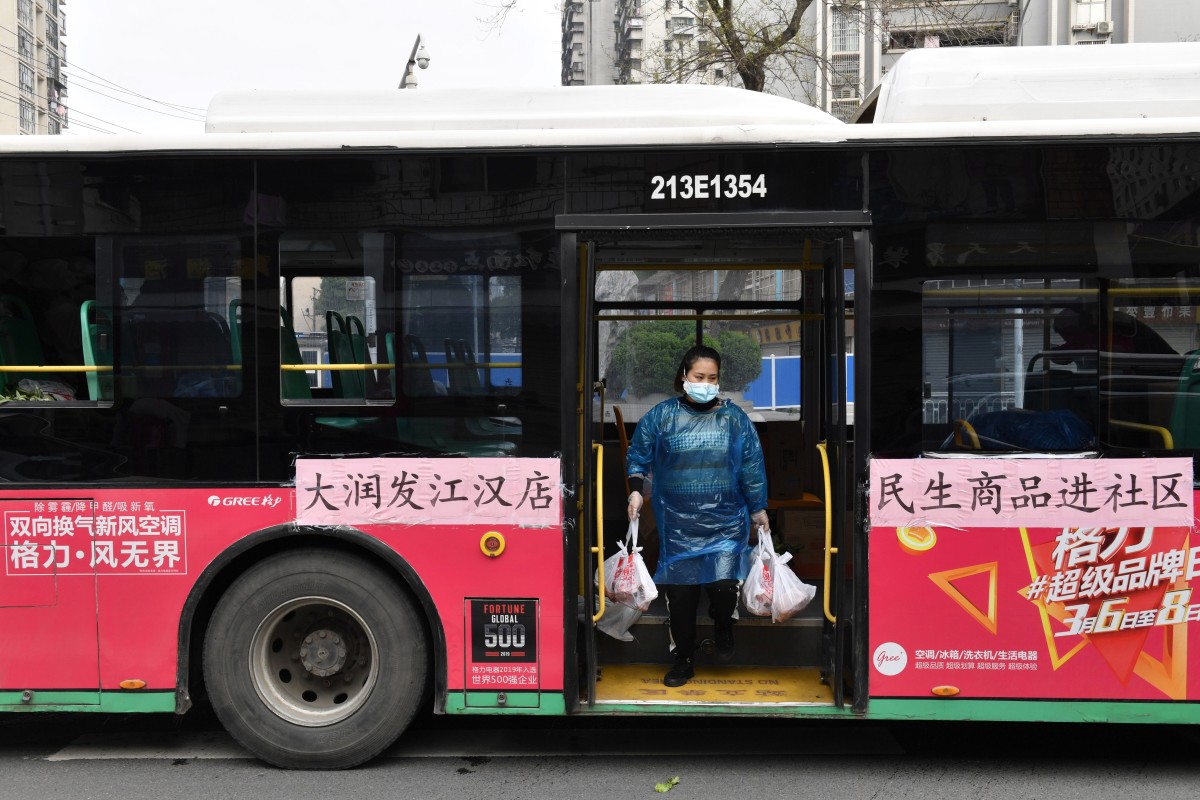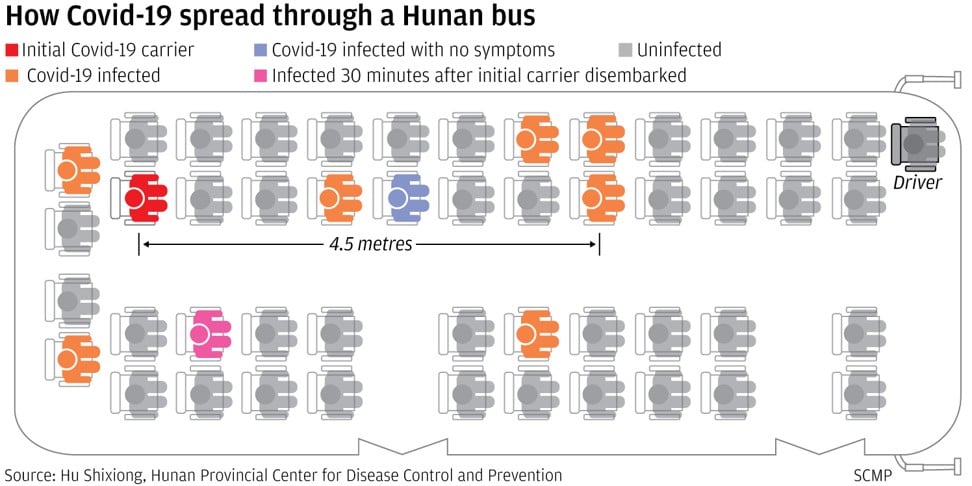Coronavirus can travel twice
as far as official ‘safe distance’ and stay in air for 30 minutes, Chinese
study finds
- Authorities advise people to stay 1-2 metres
apart, but researchers found that a bus passenger infected fellow
travellers sitting 4.5 metres away
- The scientists behind the research said their
investigation also highlighted the importance of wearing face masks
because of the length of time it can linger
Stephen Chen in Beijing
Published: 10:44pm, 9 Mar,
2020

Researchers said the case
highlighted the importance of wearing masks on public transport. Photo: Reuters
The coronavirus that causes
Covid-19 can linger in the air for at least 30 minutes and travel up to 4.5
metres – further than the “safe distance” advised by health authorities around
the world, according to a study by a team of Chinese government
epidemiologists.
The researchers also found
that it can last for days on surfaces where respiratory droplets land, raising
the risk of transmission if an unsuspecting person touches it and then rubs
their face and hands.
The length of time it lasts
on the surface depends on factors such as temperature and the type of surface,
for example at around 37C (98F), it can survive for two to three days on glass,
fabric, metal, plastic or paper.
These findings, from a group
of official researchers from Hunan province investigating a cluster case,
challenge the advice from health authorities around the world that people
should remain apart at a “safe distance” of one to two metres (three to six and
a half feet).

Several passengers became
infected during the four-hour bus journey. Graphic: SCMP
“It can be confirmed that in
a closed environment with air-conditioning, the transmission distance of the
new coronavirus will exceed the commonly recognised safe distance,” the
researchers wrote in a paper published in peer-review journal Practical
Preventive Medicine last Friday.
The paper also highlighted
the risk that the virus could remain afloat even after the carrier had left the
bus.
The scientists warned that
the coronavirus could survive more than five days in human faeces or bodily
fluids.
They said the study proves
the importance of washing hands and wearing face masks in public places because
the virus can linger in the air attached to fine droplet particles.
“Our advice is to wear a
face mask all the way [through the bus ride],” they added.
Their work was based on a
local outbreak case on January 22 during the peak Lunar New Year travel season.
A passenger, known as “A”, boarded a fully booked long-distance coach and
settled down on the second row from the back.
The passenger already felt
sick at that point but it was before China had declared the coronavirus
outbreak a national crisis, so “A” did not wear a mask, nor did most of the
other passengers or the driver on the 48-seat bus.
Confirmed Covid-19 cases
Total
110,540
cases
3,871
deaths
62,179
recovered
Cases
Deaths
Scroll to see more countries/regions
*in line with the WHO's Covid-19 situation reports
China requires closed
circuit television cameras to be installed on all long-distance buses, which
provided valuable footage for researchers to reconstruct the spread of the
virus on the bus, whose windows were all closed.
Hu Shixiong, the lead author
of the study who works for the Hunan Provincial Centre for Diseases Control and
Prevention, said the security camera footage showed patient “A” did not
interact with others throughout the four-hour ride.
But by the time the bus
stopped at the next city, the virus had already jumped from the carrier to
seven other passenger
These included not only
people sitting relatively close to “patient zero”, but also a couple of victims
six rows away from him – roughly 4.5 metres away.
They all later tested
positive, including one passenger who displayed no symptoms of the disease.
After these passengers left,
another group got on the bus about 30 minutes later. One passenger sitting in
the front row on the other side of the aisle also became infected.
Hu said the patient, who was
not wearing a mask, was likely to have inhaled aerosols, or tiny particles,
breathed out by the infected passengers from the previous group.
Aerosols are light-weighted
particles that are formed from tiny droplets of bodily fluids.
“The possible reason is that
in a completely enclosed space, the airflow is mainly driven by the hot air
generated by the air conditioning. The rise of the hot air can transport the
virus-laden droplets to a greater distance,” said the paper.
After getting off the
shuttle bus, the initial carrier got on a minibus and travelled for another
hour. The virus jumped to two other passengers, one of whom was also sitting
4.5 metres away from patient “A”.
By the time the study was
finished in mid February, patient “A” had infected at least 13 people.
It is generally believed
that the airborne transmission of Covid-19 is limited because the tiny droplets
produced by patients will quickly sink to the ground.
This belief has prompted the
Chinese health authorities to suggest that people should stay a metre apart in
public and the US Centres for Disease Control recommend a safe distance of six
feet (about 1.8 metres).
The researchers also found
that none of those passengers in the two buses who wore face masks were
infected.
They said it vindicated the
decision to ask people to wear a face mask in public.
“When riding on more closed
public transportation such as subways, cars, planes, etc, you should wear a
mask all the time, and at the same time, minimise the contact between your
hands and public areas, and avoid touching your face before cleaning,” they
said.
The researchers also
suggested improving sanitation on public transport and adjusting the air
conditioning to maximise the volume of fresh air supplied.
Italy puts 16 million people
in lockdown as coronavirus death toll spikes by over 100
They also said interiors
should cleaned and disinfected once or twice a day, especially after passengers
arrive at the terminal.
A doctor in Beijing involved
in the diagnosis and treatment of Covid-19 patients said the study had left
some questions unanswered.
For instance, the passengers
sitting immediately next to the carriers were not infected, though they were
suffering the highest exposure to the disease-bearing aerosols.
.
This article appeared in the
South China Morning Post print edition as: Coronavirus can travel for 4.5
metres
No comments:
Post a Comment
Note: Only a member of this blog may post a comment.